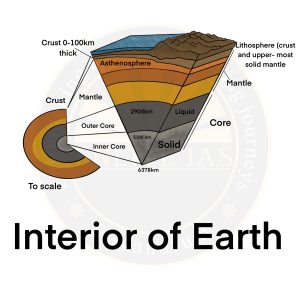Sources to Study the Earth’s Interior
- Direct Sources
- Surface Rocks
- Surface rocks are available at the surface of the Earth. By observing these rocks, we can determine from which element they are composed and at what depth they were formed.
- Example, the study of basaltic rocks makes us understand that it is made from molten material from the interior of Earth.
- Volcanoes
- Study of debris ejected out of volcanoes makes us understand that the interior of earth is hot and composed of molten material as most of the volcanic material is sourced from a layer called mantel.
- Mining and Drilling Projects
- Mining and drilling projects help understand the changes in temperature and pressure as depth increases. One of the key projects carried out was the Kola peninsula drilling project by the former U.S.S.R.
- Surface Rocks
- Indirect Sources
- Meteorites
- Meteors, as they belong to the same type of materials earth is made of.
- Gravitation Force
- Gravitational value is not the same across all the latitudes. The differences in gravitational value show the uneven distribution of mass of material within the earth.
- Magnetic Force
- Magnetic survey of the earth reveals the distribution of magnetic materials available in different parts of the earth.
- Seismic Waves
- The shadow zones of body waves (Primary and secondary waves) give us information about the state of materials in the interior.
- Meteorites
Edward Suess Classification of Earth’s Interior
- SIAL
- It is located below the crust.
- It is composed of Silica and Aluminium.
- SIMA
- It is located below SIAL and above NIFE.
- It is made of basaltic material.
- It is composed of Silica and Magnesium.
- NIFE
- It is composed of Nickel and Ferrum.
Mechanical Classification of Earth’s Interior
- Crust
- The crust is the outermost solid part and a thin layer of the earth.
- Total thickness is normally between 30-50 km.
- The thickness of the crust varies under the oceanic and continental areas.
- Oceanic crust is 5-30 km thick.
- Continental crust is 50-70 km thick. The continental crust is thicker in the areas of major mountain systems.
- Nearly 1% of the earth’s volume and 5% of earth’s mass are made of the crust.
- Temperature – The temperature of the crust increases with depth, reaching levels of around 200°C to 400°C near the mantle-crust boundary.
- Composition
- The crust’s outer layer is made up of sedimentary material, and beneath it are acidic crystalline, igneous, and metamorphic rocks.
- Basaltic and ultrabasic rocks make up the crust’s lowest layer.
- Major Elements of the Crust: Oxygen ( 46.6%), Silicon (27.7%), Aluminium (8.1%), Iron ( 5.0 %), Calcium (3.6%), Sodium (2.8%), Potassium (2.6%), Magnesium (1.6%).
- Lithosphere
- The lithosphere is the earth’s rigid outer layer.
- Thickness – 10 to 200 kilometres.
- It consists of the crust as well as the upper part of the mantle.
- Asthenosphere
- Located below the lithosphere.
- Thickness – 80-200 km
- The asthenosphere is soft and plastic in nature.
- It’s vicious, brittle, and ductile, and its density is higher than the crust.
- It is the primary source of magma that rises to the surface.
- Mantle
- The portion of the interior beyond the crust is called the mantle.
- The upper portion of the mantle is called the asthenosphere.
- It is completely solid.
- Thickness – 10-200 km
- Density – The density of the mantle is higher than the crust and varies from 3.3 to 5.5 g/cm3.
- Composition – The mantle has been formed largely of silicate minerals rich in iron and magnesium.
- Core
- Composition – nickel and iron
- Core lies between 2900 km and 6400 km below the earth’s surface.
- Density – varies from 5.5 to 13.6 g/cm3
- The core is divided into two parts: the outer core and the inner core.
- Outer Core
- Located between a depth of 2900 and 5100km.
- The outer core is liquid because it is not under enough pressure to solidify.
- Inner Core
- The inner core stretches from the earth’s centre to 5100 kilometres below the surface.
- This layer is solid in nature.
- Outer Core
Discontinuity Between Layers
|

